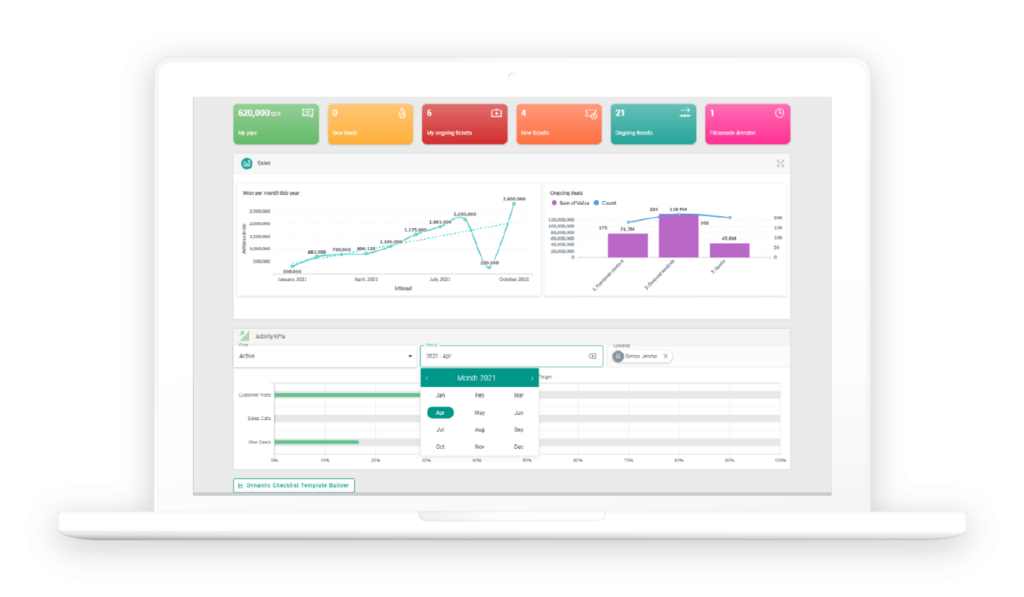6 strategies to help you find new B2B customers

You only have one chance to make a good first impression. Although first you have to meet someone new. How do you do that?
This might sound like a less enticing evening of speed-dating event, but that’s not what we’re suggesting. We must admit though, that there are a lot of similarities between sales and meeting a new life partner: You need to know what characteristics you’re looking for and where to start.
Are you unsure of the best way to charm and captivate someone? Don’t worry!
Keep reading and get inspired by our six best strategies for finding new B2B customers.
Find new customers – by getting to know your existing ones
Are your customers happy customers? If so, well done! You already have the perfect starting point for finding new prospects. Now it’s time to get to know your customers a little better.
If you already have lots of satisfied customers, try to work out what it is that makes them happy. The best way to do that is to get to know them better, right?
Here are three suggestions for activities to help you get closer to your customers:
- Invite them to a customer get-together. This is a great opportunity to bring several customers together to discuss shared challenges, services or products.
- Visit the customer at their office. Demonstrating genuine interest in your customer’s business is a good. way to build your trust capital with them.
- Organise a webinar for a few selected customers. This is like holding a digital VIP event. You can, for example, address a common problem and then discuss different solutions. To ensure everyone gets a say, it’s important to ask open questions and be inclusive.
A satisfied customer is worth their weight in gold – but that’s not to say they’ll always be happy. If you don’t live up to the customer’s expectations they can easily part ways with you and go somewhere else. And one lost customer means you have to find more new ones.
Become your ideal customer’s BFF
Best friends know each other inside out. You don’t need to ask for their opinion – you’re so in tune with each other, you “just know”. It takes years of friendship to reach an understanding like this, but let’s simplify things a little to help you understand and define your ideal customer.
The term ideal customer refers to potential customers with needs or challenges that you have solutions for. To be successful with your prospecting you want to find the golden opportunities that represent clear business possibilities within the framework of your sales process.
What do you know about that customer? And what don’t you know?
Six questions to get you closer to your ideal customer
- What type of work is your ideal customer involved in?
Define the industry, job title and regular work tasks. - Who are your ideal customer’s customers?
Your customer must be successful at selling to their customers, and so on to complete the cycle. By understanding your ideal customer’s customers, you can better understand their challenges – which makes you more able to come up with suitable solutions. - What issues do your ideal customer care about the most?
It could, for example, be financial or organisational issues, sustainability, IT security – or something else that concerns your industry and that you have solutions to. - What makes your ideal customer uncomfortable?
Does the customer avoid some of your questions or try to change the subject when you bring up a particular topic? If so, you’ve detected a potential improvement area. - What makes your ideal customer upset?
Well, let’s hope you don’t have to deal with angry customers. However, if your key customer is suddenly fuming, make sure you find out what has happened and what you can do to ease the situation. Don’t panic or freeze. Instead see it as a golden opportunity to get to know your customer better. - Who does your ideal customer trust?
It could be an individual or an organisation.

Find new companies within your network of happy customers
When you need to get a few new prospects under your belt, it’s not a bad idea to make your other customers aware of this. It doesn’t have to come across as pushy or obnoxious as long as you do it in the right way.
Explain that you have the capacity for new customers and need to find companies to work with. Clarify which industry you are targeting (it may be the same industry as the customer’s – keep the level of engagement high).
Do you have detailed information about your ideal customer? Of course! Use that information – turnover, number of employees, financial situation etc. – to articulate what your satisfied customers have in common.
Prepare your three-step approach to ask for help
You need to create a three-step information approach to make your customers (and others within your network) understand what type of prospects you are looking for:
- Mention, during a casual conversation, that you are trying to find a few new customers.
- Write an email to the customer and ask if they know of anyone they can recommend. Don’t expect to get any names of companies straight away. Keep your cool and just plant the seed every now and then.
- This can be followed up by bringing up a customer story during a relaxed chat, or include it in your social media flow as a prompt that you are still out there looking for new customers.
Be inspired by your competitors (a.k.a. industry peers)
How do you refer to those that do the same things as you? You could call them competitors, but why not see them as industry peers?
Get inspired by your industry peers to find companies and technologies that will allow you to pinpoint new potential customers. As long as you’re involved in basically the same type of business as these peers, there are hidden treasures to be found.
There’s no reason to reinvent the wheel. You don’t have to be the world’s best salesperson who’s onboarding a steady stream of new customers who become the happiest customers that have ever walked the earth. No, that’s not what we’re suggesting.
We’re just saying you need to be better than others who do roughly the same business as you do. Those ‘others’ are your industry peers! Carefully observe what they are doing, try out things they do well and learn from their mistakes. Add your own personal touch to the strategies used by them, to ensure you stand out from others and are noticed by potential customers.
“Keep your friends close but your enemies closer”
Inspiration will always come to you when you need it, as long as you keep an open mind.
Social selling will amaze your customers
Because it’s far too easy to waste time on activities that don’t generate any value. Such as reading other people’s posts without leaving any comments.
- It takes an awful lot of time and it doesn’t produce anything useful.
- The person who wrote the post won’t know that you’ve read it, and your network of contacts has no idea what type of external information you are monitoring.
- They don’t even know you’re logged in.
Having said that, there is still an enormous potential to sell and find customers via social media. The process is just a little different from the traditional sales process. The key to everything is presence and engagement.
To succeed at social selling you will, once again, need to rely on your ideal customer. That’s the type of individual you want to chat with in your social media flow. Make a note of the 10-20 individuals you really want to develop a connection with.
Then you need to let the process brew. Consider the customer a friend. Find topics to talk about, start a conversation, ask, listen and take it one step at a time.
Make use of your three-step approach to ask for help. Before you know it, a new lead will land in your inbox. Someone has noticed you – and your commitment.
Prospecting helps you prioritise amongst potential customers
Relationships are based on trust and confidence, which are the salesperson’s areas of expertise. What’s harder is the ability to segment thousands of customers and to decide who to contact. Unless you have access to a system, that is.
Prospecting, i.e. finding new customers, becomes so much easier with a CRM system that allows you to be in control of all your prospects and streamline your sales process from the first sales call until the deal is done.
A CRM system designed to close deals
Lime CRM is designed to make everyday life easier for salespeople and sales teams who wish to establish long-term relationships, maximise their sales numbers and increase their revenue.
Lime CRM provides you with an overview of all your prospects and keeps track of where you are in the sales process with each potential customer. With customised dashboards, you can even monitor your own and your team’s sales targets – which all saves you time that instead can be spent with your customers.
Lime CRM guides your sales team through every step of the sales process, from the first sales call to submitting proposals and reminding you to follow up on activities – all with the aim of closing the deal faster. In addition, the information in Lime CRM provides you with valuable insights that help you make strategic sales decisions and coach your salespeople. Voila! Your new customers are waiting for you already.

Do you want more sales?
There’s no time to waste! Let’s find the solution that will help you get more customers and turn existing ones into loyal ambassadors today.